Rubenstein School Campus
George D. Aiken Center
 The George D. Aiken Center, which opened in 1982, was built to house the Rubenstein School of Environment and Natural Resources. The building's name honors Vermont's distinguished late senator and governor. Years later, the Rubenstein School community, along with Maclay Architects of Waitsfield, Vermont, created a green, renovated Aiken Center, designed for more efficient space, sustainability, and a reduced ecological footprint. The project was completed in January 2012. The renewed Aiken Center blends ecologically designed systems and technology along with low flow fixtures, a high performance building envelope, and alternative solar energy to increase energy efficiency, naturally light the interior, and house occupants and greet visitors in a welcoming, healthy, and stimulating environment.
The George D. Aiken Center, which opened in 1982, was built to house the Rubenstein School of Environment and Natural Resources. The building's name honors Vermont's distinguished late senator and governor. Years later, the Rubenstein School community, along with Maclay Architects of Waitsfield, Vermont, created a green, renovated Aiken Center, designed for more efficient space, sustainability, and a reduced ecological footprint. The project was completed in January 2012. The renewed Aiken Center blends ecologically designed systems and technology along with low flow fixtures, a high performance building envelope, and alternative solar energy to increase energy efficiency, naturally light the interior, and house occupants and greet visitors in a welcoming, healthy, and stimulating environment.
George D. Aiken Forestry Sciences Laboratory
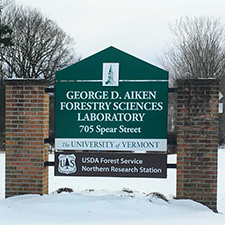 The George D. Aiken Forestry Sciences Laboratory is a Rubenstein School facility that is shared by USDA Forest Service Northern Research Station scientists and staff in partnership with Rubenstein School faculty, staff, and students. Personnel are co-located at the Aiken Center on UVM campus and at the Forestry Sciences Laboratory, about a mile from UVM campus on Spear Street. Scientists study ecosystem and forest ecology, forest adaptation to climate change, tree physiology, soil biogeochemistry, and more.
The George D. Aiken Forestry Sciences Laboratory is a Rubenstein School facility that is shared by USDA Forest Service Northern Research Station scientists and staff in partnership with Rubenstein School faculty, staff, and students. Personnel are co-located at the Aiken Center on UVM campus and at the Forestry Sciences Laboratory, about a mile from UVM campus on Spear Street. Scientists study ecosystem and forest ecology, forest adaptation to climate change, tree physiology, soil biogeochemistry, and more.
Rubenstein Ecosystem Science Laboratory
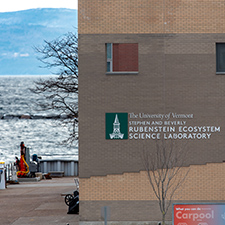 The Rubenstein Ecosystem Science Laboratory is an extension of the Rubenstein School of Environment and Natural Resources and is located at the ECHO, Leahy Center for Lake Champlain on the Burlington waterfront. The laboratory houses state-of-the-art research and teaching facilities, including laboratories for the study of water and sediment quality, contaminants, and aquatic biota including fish, invertebrates, and algae. The laboratory provides researchers with the tools necessary to investigate and understand the ecosystem processes that determine ecological health and influence the quality of life for the human community in the Lake Champlain basin.
The Rubenstein Ecosystem Science Laboratory is an extension of the Rubenstein School of Environment and Natural Resources and is located at the ECHO, Leahy Center for Lake Champlain on the Burlington waterfront. The laboratory houses state-of-the-art research and teaching facilities, including laboratories for the study of water and sediment quality, contaminants, and aquatic biota including fish, invertebrates, and algae. The laboratory provides researchers with the tools necessary to investigate and understand the ecosystem processes that determine ecological health and influence the quality of life for the human community in the Lake Champlain basin.
Partners
Environmental Program
 The Environmental Program is a community of ideas, scholars, teachers, student-teachers, and engagement that spans across the UVM campus, across the state of Vermont, and in some ways across the globe. The fabric of this big umbrella is UVM’s undergraduate student body studying the environment. The Environmental Program community includes anyone at UVM with an interest and engagement in environmental sustainability and environmental justice.
The Environmental Program is a community of ideas, scholars, teachers, student-teachers, and engagement that spans across the UVM campus, across the state of Vermont, and in some ways across the globe. The fabric of this big umbrella is UVM’s undergraduate student body studying the environment. The Environmental Program community includes anyone at UVM with an interest and engagement in environmental sustainability and environmental justice.
Forest Ecosystem Monitoring Cooperative
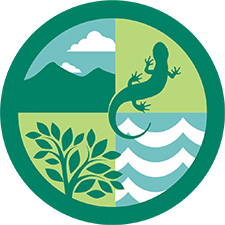 The Forest Ecosystem Monitoring Cooperative (FEMC), with staff that are part of the Rubenstein School, serves the northeast temperate forest region through improved understanding of long-term trends, annual conditions, and interdisciplinary relationships of the physical, chemical, and biological components of forested ecosystems. The FEMC also promotes the efficient coordination of multi-disciplinary environmental monitoring and research activities among federal, state, university, and private-sector agencies with common interests in the long-term health, management, and protection of forested ecosystems.
The Forest Ecosystem Monitoring Cooperative (FEMC), with staff that are part of the Rubenstein School, serves the northeast temperate forest region through improved understanding of long-term trends, annual conditions, and interdisciplinary relationships of the physical, chemical, and biological components of forested ecosystems. The FEMC also promotes the efficient coordination of multi-disciplinary environmental monitoring and research activities among federal, state, university, and private-sector agencies with common interests in the long-term health, management, and protection of forested ecosystems.
Gund Institute for Environment
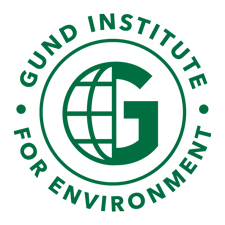 At the heart of the Gund Institute for Environment are research programs that aim to develop new ideas, test existing theories, and put the best of both into real-world practice. Gund fellows, post-docs, and students investigate interactions among ecological, social, and economic systems, and seek to use resulting insights to inform real-world policy and decisions. They develop, test, implement, and teach innovative methods and models that reflect the need to integrate the social, built, natural, and human capital components of our world. The Gund Institute is housed in Farrell Hall on the UVM campus, and many Rubenstein faculty and graduate students are Gund Fellows.
At the heart of the Gund Institute for Environment are research programs that aim to develop new ideas, test existing theories, and put the best of both into real-world practice. Gund fellows, post-docs, and students investigate interactions among ecological, social, and economic systems, and seek to use resulting insights to inform real-world policy and decisions. They develop, test, implement, and teach innovative methods and models that reflect the need to integrate the social, built, natural, and human capital components of our world. The Gund Institute is housed in Farrell Hall on the UVM campus, and many Rubenstein faculty and graduate students are Gund Fellows.
Hubbard Brook Consortium
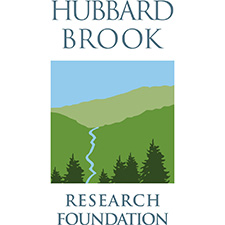 The Hubbard Brook Consortium is a collaborative of scientific and academic institutions with active research at Hubbard Brook. Situated in the White Mountains of New Hampshire, the Hubbard Brook Ecosystem Study is one of the world's most comprehensive and longest-running studies of its kind. The Hubbard Brook Experimental Forest is managed by the U.S. Forest Service, and the Ecosystem Study includes investigators from more than 25 institutions across the country. Consortium members are the Cary Institute of Ecosystem Studies, Cornell University, Dartmouth College, Plymouth State University, Syracuse University, University of Vermont, USDA Forest Service/Northern Research Station, and Wellesley College.
The Hubbard Brook Consortium is a collaborative of scientific and academic institutions with active research at Hubbard Brook. Situated in the White Mountains of New Hampshire, the Hubbard Brook Ecosystem Study is one of the world's most comprehensive and longest-running studies of its kind. The Hubbard Brook Experimental Forest is managed by the U.S. Forest Service, and the Ecosystem Study includes investigators from more than 25 institutions across the country. Consortium members are the Cary Institute of Ecosystem Studies, Cornell University, Dartmouth College, Plymouth State University, Syracuse University, University of Vermont, USDA Forest Service/Northern Research Station, and Wellesley College.
Lake Champlain Sea Grant
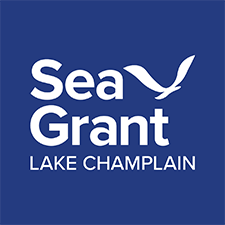 Lake Champlain Sea Grant is a cooperative program of the University of Vermont Rubenstein School and State University of New York Plattsburgh and part of a national network coordinated by the National Oceanic and Atmospheric Administration. Their mission is to identify and address critical ecological and economic issues affecting the Lake Champlain basin and its resources and to share that information with communities, businesses, and other stakeholders.
Lake Champlain Sea Grant is a cooperative program of the University of Vermont Rubenstein School and State University of New York Plattsburgh and part of a national network coordinated by the National Oceanic and Atmospheric Administration. Their mission is to identify and address critical ecological and economic issues affecting the Lake Champlain basin and its resources and to share that information with communities, businesses, and other stakeholders.
McIntire-Stennis Cooperative Forestry Research Program
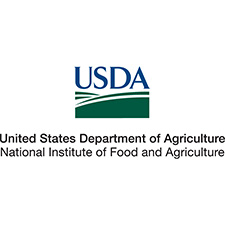 The McIntire-Stennis Cooperative Forestry Research Program in the Rubenstein School is funded through the USDA National Institute of Food and Agriculture as a formula-based program for forestry and natural resources research at land-grant and related universities. The program provides funding for critical state and regionally focused forestry and natural resources research, including graduate student support. The Rubenstein School uses McIntire-Stennis funds to develop research programs that result in a greater understanding of forestry and natural resource issues and practices and their effects on management, public policy, and economic and social systems.
The McIntire-Stennis Cooperative Forestry Research Program in the Rubenstein School is funded through the USDA National Institute of Food and Agriculture as a formula-based program for forestry and natural resources research at land-grant and related universities. The program provides funding for critical state and regionally focused forestry and natural resources research, including graduate student support. The Rubenstein School uses McIntire-Stennis funds to develop research programs that result in a greater understanding of forestry and natural resource issues and practices and their effects on management, public policy, and economic and social systems.
Northeastern States Research Cooperative
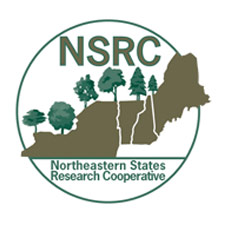 The Northeastern States Research Cooperative (NSRC) is a competitive research grant program jointly directed by the USDA Forest Service Northern Research Station and a designated institution, including the University of Vermont Rubenstein School, in each of the four Northern Forest states. NSRC supports cross-disciplinary, collaborative research in the Northern Forest - a 26-million-acre working landscape that stretches from eastern Maine through New Hampshire and Vermont and into northern New York. A central component of the program is the importance of the Northern Forest to society and the need for research activities to have relevance and benefit to the people who live within its boundaries, work with its resources, use its products, visit it, and care about it.
The Northeastern States Research Cooperative (NSRC) is a competitive research grant program jointly directed by the USDA Forest Service Northern Research Station and a designated institution, including the University of Vermont Rubenstein School, in each of the four Northern Forest states. NSRC supports cross-disciplinary, collaborative research in the Northern Forest - a 26-million-acre working landscape that stretches from eastern Maine through New Hampshire and Vermont and into northern New York. A central component of the program is the importance of the Northern Forest to society and the need for research activities to have relevance and benefit to the people who live within its boundaries, work with its resources, use its products, visit it, and care about it.
Northern Institute of Applied Climate Science
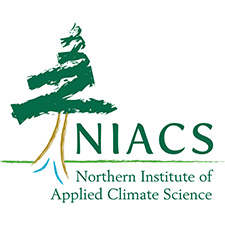 The Northern Institute of Applied Climate Science (NIACS) is a collaborative effort among the USDA Forest Service Northern Research Station, universities, and forest industry to provide information on managing forests for climate change adaptation, enhanced carbon sequestration, and sustainable production of bioenergy and materials. NIACS builds partnerships, facilitates research, and synthesizes information to bridge the gap between carbon and climate science research and the information and management needs of land owners and managers, policymakers, and members of the public.
The Northern Institute of Applied Climate Science (NIACS) is a collaborative effort among the USDA Forest Service Northern Research Station, universities, and forest industry to provide information on managing forests for climate change adaptation, enhanced carbon sequestration, and sustainable production of bioenergy and materials. NIACS builds partnerships, facilitates research, and synthesizes information to bridge the gap between carbon and climate science research and the information and management needs of land owners and managers, policymakers, and members of the public.
USDA Forest Service Northern Research Station
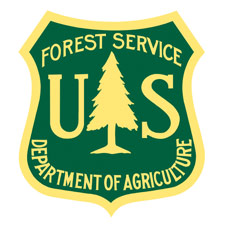 The USDA Forest Service Northern Research Station scientists and staff in partnership with Rubenstein School faculty, staff, and students share the George D. Aiken Forestry Sciences Laboratory, a Rubenstein School facility located about a mile from UVM campus on Spear Street. Personnel are co-located at the Aiken Center on UVM campus and at the Forestry Sciences Laboratory. Rubenstein School faculty, staff, and students collaborate with Forest Service scientists and staff on forest science research.
The USDA Forest Service Northern Research Station scientists and staff in partnership with Rubenstein School faculty, staff, and students share the George D. Aiken Forestry Sciences Laboratory, a Rubenstein School facility located about a mile from UVM campus on Spear Street. Personnel are co-located at the Aiken Center on UVM campus and at the Forestry Sciences Laboratory. Rubenstein School faculty, staff, and students collaborate with Forest Service scientists and staff on forest science research.
University of Vermont Extension
 Located throughout the state, UVM Extension integrates higher education, research, and outreach to help Vermonters put knowledge to work in their families and homes, farms and businesses, towns and the natural environment. Faculty and staff help improve the quality of life of Vermonters through research-based educational programs and practical information. Some Extension faculty are housed in the Rubenstein School.
Located throughout the state, UVM Extension integrates higher education, research, and outreach to help Vermonters put knowledge to work in their families and homes, farms and businesses, towns and the natural environment. Faculty and staff help improve the quality of life of Vermonters through research-based educational programs and practical information. Some Extension faculty are housed in the Rubenstein School.
University of Vermont Watershed Alliance
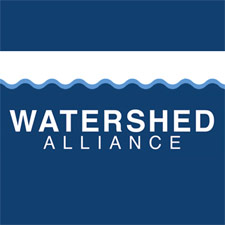 The University of Vermont Watershed Alliance is an Extension program in partnership with Lake Champlain Sea Grant and the Rubenstein School. Their primary objective is to increase awareness and knowledge of watershed issues in Vermont youth. The Alliance provides curriculum, equipment, and instructors to K-12 schools and youth groups participating in their programs, as well as support and guidance to teachers who wish to integrate watershed education into their curriculum.
The University of Vermont Watershed Alliance is an Extension program in partnership with Lake Champlain Sea Grant and the Rubenstein School. Their primary objective is to increase awareness and knowledge of watershed issues in Vermont youth. The Alliance provides curriculum, equipment, and instructors to K-12 schools and youth groups participating in their programs, as well as support and guidance to teachers who wish to integrate watershed education into their curriculum.
Vermont Cooperative Fish & Wildlife Research Unit
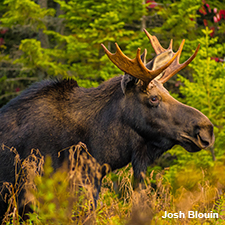 The U.S. Geological Survey (USGS) Cooperative Research Units were created to enhance graduate education in fisheries and wildlife sciences and facilitate cooperative research among federal and state natural resource agencies and universities. Research at the Vermont Cooperative Fish & Wildlife Research Unit, located in the Rubenstein School, is problem-oriented and provides cooperators (Vermont Department of Fish and Wildlife, the University of Vermont, USGS, and Wildlife Management Institute) and other agencies with useful and practical information needed to understand and manage fish and wildlife resources in Vermont.
The U.S. Geological Survey (USGS) Cooperative Research Units were created to enhance graduate education in fisheries and wildlife sciences and facilitate cooperative research among federal and state natural resource agencies and universities. Research at the Vermont Cooperative Fish & Wildlife Research Unit, located in the Rubenstein School, is problem-oriented and provides cooperators (Vermont Department of Fish and Wildlife, the University of Vermont, USGS, and Wildlife Management Institute) and other agencies with useful and practical information needed to understand and manage fish and wildlife resources in Vermont.
Vermont Water Resources and Lake Studies Center
 The Vermont Water Resources and Lake Studies Center at the University of Vermont is one of 54 institutes established by Congress through the Water Resources Research Act of 1964. Throughout its history, the Center has served the citizens of the state of Vermont by funding research on major issues of concern to the state, by disseminating and distributing information on water resources throughout Vermont, and by helping to educate students about the various aspects of water resources. The Center is administered in the Rubenstein School.
The Vermont Water Resources and Lake Studies Center at the University of Vermont is one of 54 institutes established by Congress through the Water Resources Research Act of 1964. Throughout its history, the Center has served the citizens of the state of Vermont by funding research on major issues of concern to the state, by disseminating and distributing information on water resources throughout Vermont, and by helping to educate students about the various aspects of water resources. The Center is administered in the Rubenstein School.
Research and Teaching Facilities
Research Vessel Marcelle Melosira
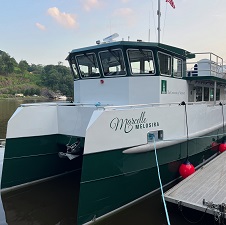 The Rubenstein School owns a new hybrid-electric research vessel, the Marcelle Melosira, which is docked at the Rubenstein Ecosystem Science Laboratory on Lake Champlain in Burlington. The Marcelle Melosira is used for research, teaching, and outreach on the Lake.
The Rubenstein School owns a new hybrid-electric research vessel, the Marcelle Melosira, which is docked at the Rubenstein Ecosystem Science Laboratory on Lake Champlain in Burlington. The Marcelle Melosira is used for research, teaching, and outreach on the Lake.
Spatial Analysis Lab
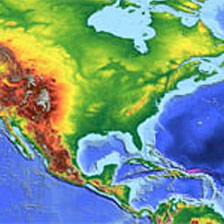 The Spatial Analysis Laboratory is a research facility located in the Rubenstein School. Laboratory staff are employees or students in the School, but facilities are often shared with collaborators from other units (UVM Geography Department, Gund Institute for Ecological Economics, and the USDA Forest Service Northern Research Station). The Laboratory applies techniques in GIS, remote sensing, and spatial statistics to problems in natural resource ecology and natural resources planning. The Lab specializes in biodiversity analysis, land-cover mapping, planning for conservation lands, and development of new applications for natural resource management.
The Spatial Analysis Laboratory is a research facility located in the Rubenstein School. Laboratory staff are employees or students in the School, but facilities are often shared with collaborators from other units (UVM Geography Department, Gund Institute for Ecological Economics, and the USDA Forest Service Northern Research Station). The Laboratory applies techniques in GIS, remote sensing, and spatial statistics to problems in natural resource ecology and natural resources planning. The Lab specializes in biodiversity analysis, land-cover mapping, planning for conservation lands, and development of new applications for natural resource management.
University of Vermont Forests
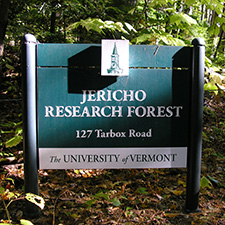 The University of Vermont Forests provide a range of northern forest ecoystems for research, teaching, and demonstration. The University owns four forests throughout the State of Vermont: Jericho Research Forest, Talcott Woods, and Wolcott Research Forest in northern Vermont and Washington Research Forest in central Vermont. The Rubenstein School manages each forest.
The University of Vermont Forests provide a range of northern forest ecoystems for research, teaching, and demonstration. The University owns four forests throughout the State of Vermont: Jericho Research Forest, Talcott Woods, and Wolcott Research Forest in northern Vermont and Washington Research Forest in central Vermont. The Rubenstein School manages each forest.
University of Vermont Natural Areas
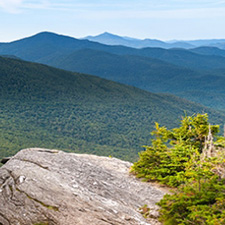 In 1974, the University of Vermont Board of Trustees established the University of Vermont Natural Areas. By this action, the Board of Trustees recognized the University's responsibility of leadership in identification, protection, and management of important natural areas on University-owned lands. From more than one thousand acres along the shoreline of Shelburne Pond to less than three acres at Redstone Quarry, from the lowlands of Colchester Bog to the summit of Mount Mansfield, Vermont's highest peak, these ten natural areas provide outstanding resources to meet teaching and research needs in disciplines that require or benefit from field experience. The UVM Environmental Program manages the natural areas.
In 1974, the University of Vermont Board of Trustees established the University of Vermont Natural Areas. By this action, the Board of Trustees recognized the University's responsibility of leadership in identification, protection, and management of important natural areas on University-owned lands. From more than one thousand acres along the shoreline of Shelburne Pond to less than three acres at Redstone Quarry, from the lowlands of Colchester Bog to the summit of Mount Mansfield, Vermont's highest peak, these ten natural areas provide outstanding resources to meet teaching and research needs in disciplines that require or benefit from field experience. The UVM Environmental Program manages the natural areas.
Vermont Tourism Research Center
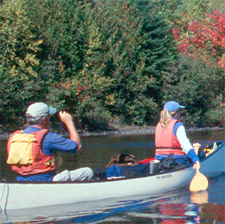 The Vermont Tourism Research Center, administered by faculty at UVM Extension, is the only research center in the state focusing on tourism and recreation. The Center specializes in tourism that strengthens community vitality and promotes environmental stewardship. Experienced staff and affiliates include professors, research specialists, business owners and managers, and graduate students.
The Vermont Tourism Research Center, administered by faculty at UVM Extension, is the only research center in the state focusing on tourism and recreation. The Center specializes in tourism that strengthens community vitality and promotes environmental stewardship. Experienced staff and affiliates include professors, research specialists, business owners and managers, and graduate students.
